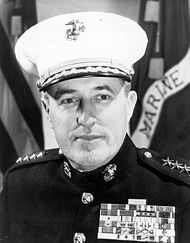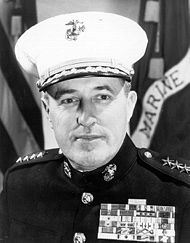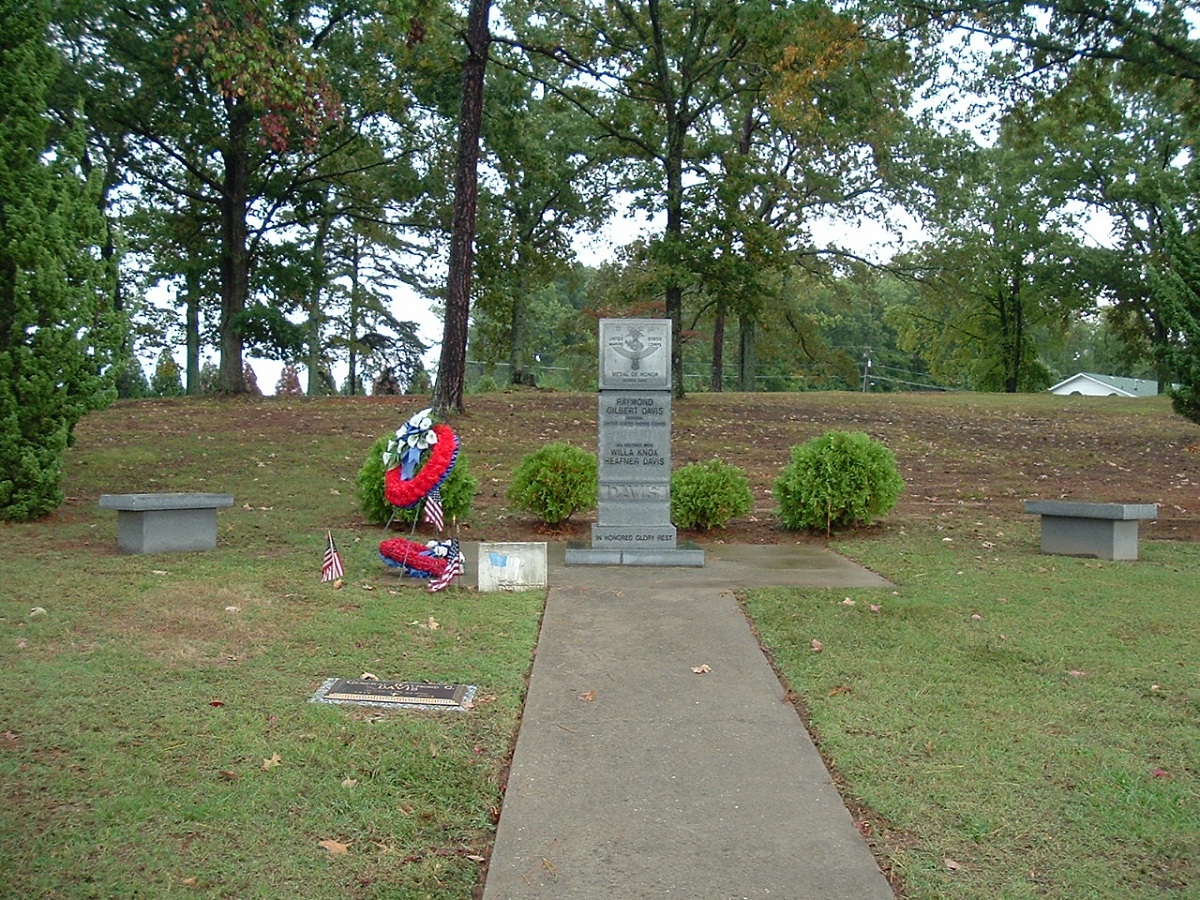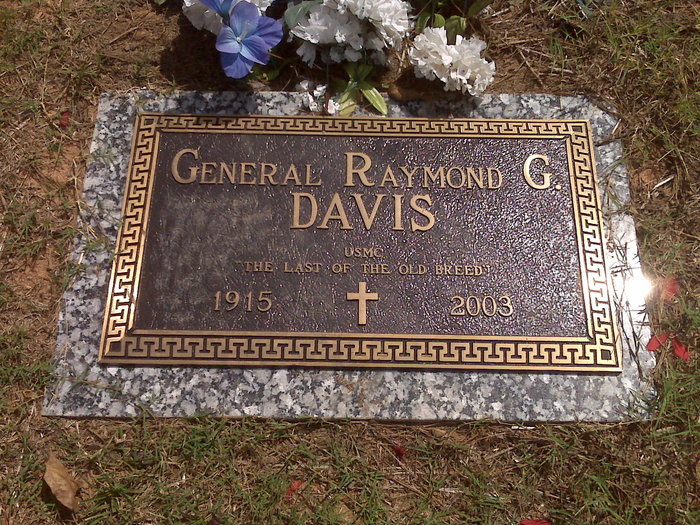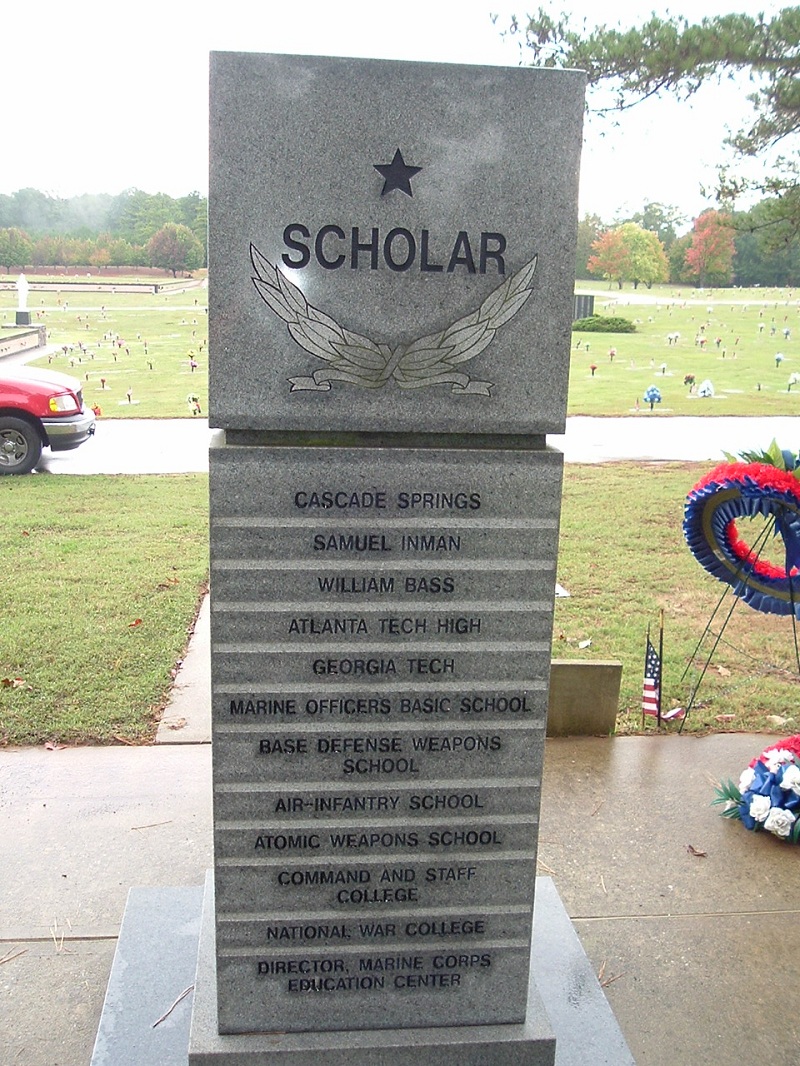Korean War Medal of Honor Recipient. He was a highly decorated US Marine Corps officer who served in World War II, the Korean War, and the Vietnam War. Born in Fitzgerald, Georgia, he graduated from Atlanta Technical High School, Atlanta, Georgia in 1933. He then enrolled at the Georgia Institute of Technology (also known as Georgia Tech) in Atlanta and graduated in 1938 with a Bachelor of Science Degree in Chemical Engineering. While in college he was a member of the US Army Reserve Officers' Training Corps unit. After graduation, he resigned his commission in the US Army Infantry Reserve to accept appointment as a Marine Corps 2nd lieutenant on June 27, 1938. In May 1939 he completed the Marine Officers' Basic School at the Philadelphia Navy Yard, Philadelphia, Pennsylvania and began a year of service with the Marine Detachment on board the USS Portland in the Pacific. In July 1940 he returned to the US for weapons and artillery instruction at Quantico, Virginia, and Aberdeen, Maryland. In February 1941 he was assigned to the 1st Antiaircraft Machine Gun Battery, 1st Marine Division at Guantanamo Bay, Cuba. Two months later, he returned to the US with the unit and the following month was appointed battery executive officer, serving in that capacity at Parris Island, South Carolina, and Quantico. Promoted to the rank of 1st lieutenant in August 1941, he then moved with the battery to the Marine Barracks, New River (later Camp Lejeune), North Carolina. Upon his promotion to the rank of captain in February 1942, he was named battery commander. In June 1942, after the outbreak of the US involvement in World War II, he was sent with his unit to the Pacific Theater, where he first participated in combat at the Guadalcanal-Tulagi landings and the capture and defense of Guadalcanal landing at Guadalcanal. After that campaign, he was appointed Executive Officer of the 1st Special Weapons Battalion, 1st Marine Division. In February 1943 he was promoted to the rank of major and in October of that year, he assumed command of the battalion and served in that capacity at New Guinea and Cape Gloucester. In April 1944, while on Cape Gloucester, he was named Commanding Officer, 1st Battalion, 1st Marine Regiment, 1st Marine Division. In September 1944 he saw action at Peleliu and his extraordinary heroism earned him the Navy Cross and Purple Heart Medal. During the first hour of the Peleliu landing he was wounded but he refused evacuation, and on one occasion, due to heavy Marine casualties and point-blank Japanese cannon fire, the Japanese broke through, he personally rallied and led his men in fighting to re-establish defensive positions. In October 1944, he returned to Pavuvu and was promoted to the rank of lieutenant colonel. In November 1944 he returned to the US and was assigned to Quantico as Tactical Inspector, Marine Corps Schools. In May 1945 he was named Chief of the Infantry Section, Marine Air-Infantry School, Quantico, and served in that position for two years before returning to the Pacific area in July 1947 to serve with the 1st Provisional Marine Brigade on Guam. He was the 1st Brigade's Assistant Chief of Staff, G-3 (Operations and Training), until August 1948, and from then until May 1949, was Assistant Chief of Staff, G-4 (Logistics). He returned to the US in May 1949, and was named Inspector-Instructor of the 9th Marine Corps Reserve Infantry Battalion in Chicago, Illinois, serving there until August 1950 when he was sent to Korea in response to the outbreak of the Korean War, where he commanded the 1st Battalion, 7th Marines until December 1950. His action at the Battle of the Chosin Reservoir on December 1, 1950 led to his award of the Medal of Honor as well as two Silver Stars. He then became the Executive Officer of the 7th Marines until June 1951 and he returned to the US where he was assigned to the Headquarters Marine Corps in Washington, DC, where served in the Operations Subsection, G-3, Division of Plans and Policies, until February 1952, when he took charge of the subsection. In April 1953, he became Head of the Operations and Training Branch, G-3 Division and while serving in this capacity, he was promoted to the rank of colonel in October 1953. In July 1954 he attended the Special Weapons Employment Course, Fleet Training Center, Norfolk, Virginia, and in September 1954, he entered the Senior Course, Marine Corps Schools, Quantico. After graduating in June 1955, he served consecutively as Assistant Director and, later, Director, of the Senior School. In October 1957, he was again transferred to Washington, DC and served there as Assistant G-2, Headquarters Marine Corps, until August 1959, when he was sent to the National War College at Fort McNair, Washington DC, graduating in June 1960. His next assignment was to the Headquarters, United States European Command, in Paris, France, serving from July 1960 through June 1963 as Chief, Analysis Branch, J-2, Staff of the Commander in Chief, Europe. On July 1, 1963, he was promoted to the rank of brigadier general and was sent to Okinawa where he became the Assistant Division Commander, 3rd Marine Division, Fleet Marine Force, serving there until November 1964. During this period he also performed additional duty as Commanding General, SEATO Expeditionary Brigade, EXLIGTAS, in the Philippines, during June 1964, and as Commanding General, 9th Marine Expeditionary Brigade, in China Sea Contingency Operations, from August 2, to October 16, 1964. He returned to the US and in December 1964, he was assigned to Headquarters Marine Corps in Washington DC, where he served as Assistant Director of Personnel until March 1965, then served as Assistant Chief of Staff, G-1, until March 1968. He was promoted to major general in November 1966. In March 1968 he was sent to the Republic of Vietnam and served until May 1968 as the Deputy Commanding General of the Provisional Corps in South Vietnam. He then became Commanding General, 3rd Marine Division until April 1969. He then returned to the US where he was became the Deputy for Education with additional duty as Director, Education Center, Marine Corps Development and Education Command, Quantico, Virginia. After his promotion to the rank of lieutenant general on July 1, 1970, he was reassigned duty as Commanding General, Marine Corps Development and Education Command (Marine Corps Combat Development Command). On March 12, 1971 he was promoted to the rank of general and was assigned as the Assistant Commandant of the Marine Corps until he retired from active duty on March 31, 1972, with 34 years of continued active duty service in the US Marine Corps. Among his military decorations and awards in addition to the Medal of Honor and the Silver Star with gold star, include the Navy Cross, the Navy Distinguished Service Medal with gold star, the Legion of Merit with one gold star and Combat "V" device, the Bronze Star, the Purple Heart, the Presidential Unit Citation with four bronze service stars, the Navy Unit Commendation with one bronze service star, The American Defense Service Medal, the American Campaign Medal, the Asiatic-Pacific Campaign Medal with one silver star, the World War II Victory Medal, the National Defense Service Medal with one bronze service star, the Korean Service Medal with four bronze service stars, the Vietnam Service Medal with three bronze service stars, the United Nations Service Medal, and the Vietnam Campaign Medal. His foreign awards and decorations include the National Order of Vietnam, Officer, the National Order of Vietnam, Knight, the Vietnam Army Distinguished Service Order, 2nd Class, the Republic of Vietnam Gallantry Cross with three palms, the Vietnam Civil Actions Medal with palm, the Republic of Korea Presidential Unit Citation, and the Republic of Vietnam Gallantry Cross Unit Citation. He died in Conyers, Georgia at the age of 88. In 2003 he was awarded the James A. Van Fleet Award by the Korea Society. His Medal of Honor citation reads: " For conspicuous gallantry and intrepidity at the risk of his life above and beyond the call of duty as commanding officer of the 1st Battalion, in action against enemy aggressor forces. Although keenly aware that the operation involved breaking through a surrounding enemy and advancing 8 miles along primitive icy trails in the bitter cold with every passage disputed by a savage and determined foe, Lt. Col. Davis boldly led his battalion into the attack in a daring attempt to relieve a beleaguered rifle company and to seize, hold, and defend a vital mountain pass controlling the only route available for 2 marine regiments in danger of being cut off by numerically superior hostile forces during their re-deployment to the port of Hungnam. When the battalion immediately encountered strong opposition from entrenched enemy forces commanding high ground in the path of the advance, he promptly spearheaded his unit in a fierce attack up the steep, ice-covered slopes in the face of withering fire and, personally leading the assault groups in a hand-to-hand encounter, drove the hostile troops from their positions, rested his men, and reconnoitered the area under enemy fire to determine the best route for continuing the mission. Always in the thick of the fighting Lt. Col. Davis led his battalion over 3 successive ridges in the deep snow in continuous attacks against the enemy and, constantly inspiring and encouraging his men throughout the night, brought his unit to a point within 1,500 yards of the surrounded rifle company by daybreak. Although knocked to the ground when a shell fragment struck his helmet and 2 bullets pierced his clothing, he arose and fought his way forward at the head of his men until he reached the isolated marines. On the following morning, he bravely led his battalion in securing the vital mountain pass from a strongly entrenched and numerically superior hostile force, carrying all his wounded with him, including 22 litter cases and numerous ambulatory patients. Despite repeated savage and heavy assaults by the enemy, he stubbornly held the vital terrain until the 2 regiments of the division had deployed through the pass and, on the morning of December 4, led his battalion into Hagaru-ri intact. By his superb leadership, outstanding courage, and brilliant tactical ability, Lt. Col. Davis was directly instrumental in saving the beleaguered rifle company from complete annihilation and enabled the 2 marine regiments to escape possible destruction. His valiant devotion to duty and unyielding fighting spirit in the face of almost insurmountable odds enhance and sustain the highest traditions of the U.S. Naval Service."
Korean War Medal of Honor Recipient. He was a highly decorated US Marine Corps officer who served in World War II, the Korean War, and the Vietnam War. Born in Fitzgerald, Georgia, he graduated from Atlanta Technical High School, Atlanta, Georgia in 1933. He then enrolled at the Georgia Institute of Technology (also known as Georgia Tech) in Atlanta and graduated in 1938 with a Bachelor of Science Degree in Chemical Engineering. While in college he was a member of the US Army Reserve Officers' Training Corps unit. After graduation, he resigned his commission in the US Army Infantry Reserve to accept appointment as a Marine Corps 2nd lieutenant on June 27, 1938. In May 1939 he completed the Marine Officers' Basic School at the Philadelphia Navy Yard, Philadelphia, Pennsylvania and began a year of service with the Marine Detachment on board the USS Portland in the Pacific. In July 1940 he returned to the US for weapons and artillery instruction at Quantico, Virginia, and Aberdeen, Maryland. In February 1941 he was assigned to the 1st Antiaircraft Machine Gun Battery, 1st Marine Division at Guantanamo Bay, Cuba. Two months later, he returned to the US with the unit and the following month was appointed battery executive officer, serving in that capacity at Parris Island, South Carolina, and Quantico. Promoted to the rank of 1st lieutenant in August 1941, he then moved with the battery to the Marine Barracks, New River (later Camp Lejeune), North Carolina. Upon his promotion to the rank of captain in February 1942, he was named battery commander. In June 1942, after the outbreak of the US involvement in World War II, he was sent with his unit to the Pacific Theater, where he first participated in combat at the Guadalcanal-Tulagi landings and the capture and defense of Guadalcanal landing at Guadalcanal. After that campaign, he was appointed Executive Officer of the 1st Special Weapons Battalion, 1st Marine Division. In February 1943 he was promoted to the rank of major and in October of that year, he assumed command of the battalion and served in that capacity at New Guinea and Cape Gloucester. In April 1944, while on Cape Gloucester, he was named Commanding Officer, 1st Battalion, 1st Marine Regiment, 1st Marine Division. In September 1944 he saw action at Peleliu and his extraordinary heroism earned him the Navy Cross and Purple Heart Medal. During the first hour of the Peleliu landing he was wounded but he refused evacuation, and on one occasion, due to heavy Marine casualties and point-blank Japanese cannon fire, the Japanese broke through, he personally rallied and led his men in fighting to re-establish defensive positions. In October 1944, he returned to Pavuvu and was promoted to the rank of lieutenant colonel. In November 1944 he returned to the US and was assigned to Quantico as Tactical Inspector, Marine Corps Schools. In May 1945 he was named Chief of the Infantry Section, Marine Air-Infantry School, Quantico, and served in that position for two years before returning to the Pacific area in July 1947 to serve with the 1st Provisional Marine Brigade on Guam. He was the 1st Brigade's Assistant Chief of Staff, G-3 (Operations and Training), until August 1948, and from then until May 1949, was Assistant Chief of Staff, G-4 (Logistics). He returned to the US in May 1949, and was named Inspector-Instructor of the 9th Marine Corps Reserve Infantry Battalion in Chicago, Illinois, serving there until August 1950 when he was sent to Korea in response to the outbreak of the Korean War, where he commanded the 1st Battalion, 7th Marines until December 1950. His action at the Battle of the Chosin Reservoir on December 1, 1950 led to his award of the Medal of Honor as well as two Silver Stars. He then became the Executive Officer of the 7th Marines until June 1951 and he returned to the US where he was assigned to the Headquarters Marine Corps in Washington, DC, where served in the Operations Subsection, G-3, Division of Plans and Policies, until February 1952, when he took charge of the subsection. In April 1953, he became Head of the Operations and Training Branch, G-3 Division and while serving in this capacity, he was promoted to the rank of colonel in October 1953. In July 1954 he attended the Special Weapons Employment Course, Fleet Training Center, Norfolk, Virginia, and in September 1954, he entered the Senior Course, Marine Corps Schools, Quantico. After graduating in June 1955, he served consecutively as Assistant Director and, later, Director, of the Senior School. In October 1957, he was again transferred to Washington, DC and served there as Assistant G-2, Headquarters Marine Corps, until August 1959, when he was sent to the National War College at Fort McNair, Washington DC, graduating in June 1960. His next assignment was to the Headquarters, United States European Command, in Paris, France, serving from July 1960 through June 1963 as Chief, Analysis Branch, J-2, Staff of the Commander in Chief, Europe. On July 1, 1963, he was promoted to the rank of brigadier general and was sent to Okinawa where he became the Assistant Division Commander, 3rd Marine Division, Fleet Marine Force, serving there until November 1964. During this period he also performed additional duty as Commanding General, SEATO Expeditionary Brigade, EXLIGTAS, in the Philippines, during June 1964, and as Commanding General, 9th Marine Expeditionary Brigade, in China Sea Contingency Operations, from August 2, to October 16, 1964. He returned to the US and in December 1964, he was assigned to Headquarters Marine Corps in Washington DC, where he served as Assistant Director of Personnel until March 1965, then served as Assistant Chief of Staff, G-1, until March 1968. He was promoted to major general in November 1966. In March 1968 he was sent to the Republic of Vietnam and served until May 1968 as the Deputy Commanding General of the Provisional Corps in South Vietnam. He then became Commanding General, 3rd Marine Division until April 1969. He then returned to the US where he was became the Deputy for Education with additional duty as Director, Education Center, Marine Corps Development and Education Command, Quantico, Virginia. After his promotion to the rank of lieutenant general on July 1, 1970, he was reassigned duty as Commanding General, Marine Corps Development and Education Command (Marine Corps Combat Development Command). On March 12, 1971 he was promoted to the rank of general and was assigned as the Assistant Commandant of the Marine Corps until he retired from active duty on March 31, 1972, with 34 years of continued active duty service in the US Marine Corps. Among his military decorations and awards in addition to the Medal of Honor and the Silver Star with gold star, include the Navy Cross, the Navy Distinguished Service Medal with gold star, the Legion of Merit with one gold star and Combat "V" device, the Bronze Star, the Purple Heart, the Presidential Unit Citation with four bronze service stars, the Navy Unit Commendation with one bronze service star, The American Defense Service Medal, the American Campaign Medal, the Asiatic-Pacific Campaign Medal with one silver star, the World War II Victory Medal, the National Defense Service Medal with one bronze service star, the Korean Service Medal with four bronze service stars, the Vietnam Service Medal with three bronze service stars, the United Nations Service Medal, and the Vietnam Campaign Medal. His foreign awards and decorations include the National Order of Vietnam, Officer, the National Order of Vietnam, Knight, the Vietnam Army Distinguished Service Order, 2nd Class, the Republic of Vietnam Gallantry Cross with three palms, the Vietnam Civil Actions Medal with palm, the Republic of Korea Presidential Unit Citation, and the Republic of Vietnam Gallantry Cross Unit Citation. He died in Conyers, Georgia at the age of 88. In 2003 he was awarded the James A. Van Fleet Award by the Korea Society. His Medal of Honor citation reads: " For conspicuous gallantry and intrepidity at the risk of his life above and beyond the call of duty as commanding officer of the 1st Battalion, in action against enemy aggressor forces. Although keenly aware that the operation involved breaking through a surrounding enemy and advancing 8 miles along primitive icy trails in the bitter cold with every passage disputed by a savage and determined foe, Lt. Col. Davis boldly led his battalion into the attack in a daring attempt to relieve a beleaguered rifle company and to seize, hold, and defend a vital mountain pass controlling the only route available for 2 marine regiments in danger of being cut off by numerically superior hostile forces during their re-deployment to the port of Hungnam. When the battalion immediately encountered strong opposition from entrenched enemy forces commanding high ground in the path of the advance, he promptly spearheaded his unit in a fierce attack up the steep, ice-covered slopes in the face of withering fire and, personally leading the assault groups in a hand-to-hand encounter, drove the hostile troops from their positions, rested his men, and reconnoitered the area under enemy fire to determine the best route for continuing the mission. Always in the thick of the fighting Lt. Col. Davis led his battalion over 3 successive ridges in the deep snow in continuous attacks against the enemy and, constantly inspiring and encouraging his men throughout the night, brought his unit to a point within 1,500 yards of the surrounded rifle company by daybreak. Although knocked to the ground when a shell fragment struck his helmet and 2 bullets pierced his clothing, he arose and fought his way forward at the head of his men until he reached the isolated marines. On the following morning, he bravely led his battalion in securing the vital mountain pass from a strongly entrenched and numerically superior hostile force, carrying all his wounded with him, including 22 litter cases and numerous ambulatory patients. Despite repeated savage and heavy assaults by the enemy, he stubbornly held the vital terrain until the 2 regiments of the division had deployed through the pass and, on the morning of December 4, led his battalion into Hagaru-ri intact. By his superb leadership, outstanding courage, and brilliant tactical ability, Lt. Col. Davis was directly instrumental in saving the beleaguered rifle company from complete annihilation and enabled the 2 marine regiments to escape possible destruction. His valiant devotion to duty and unyielding fighting spirit in the face of almost insurmountable odds enhance and sustain the highest traditions of the U.S. Naval Service."
Bio by: William Bjornstad
Family Members
Advertisement
